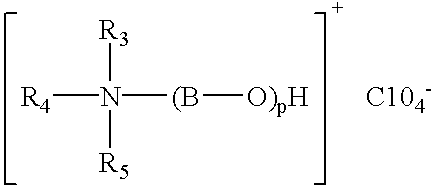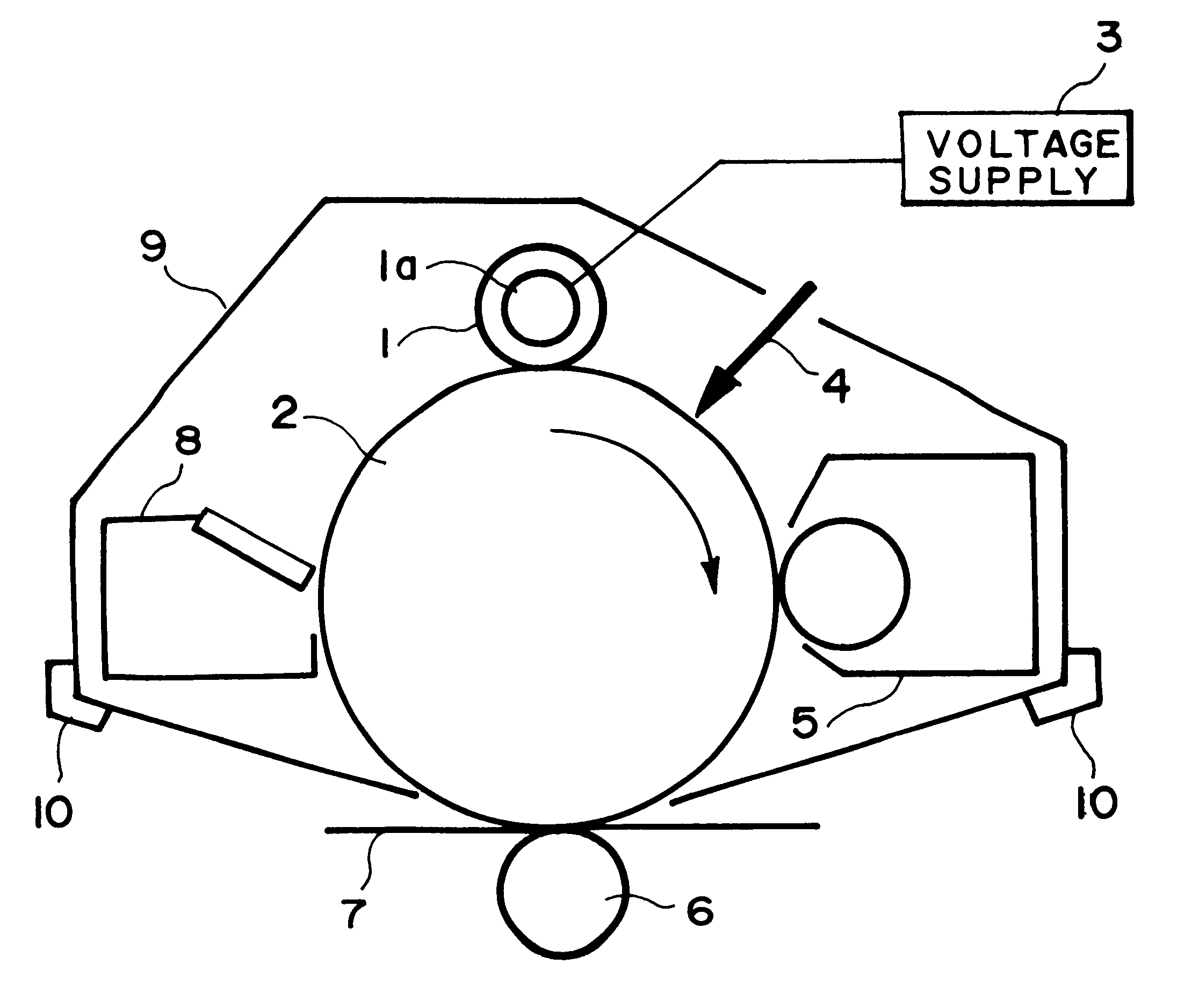Conductive roller, process cartridge and image forming apparatus
a technology of image forming apparatus and conductive roller, which is applied in the direction of corona discharge, plastic/resin/waxes insulators, instruments, etc., can solve the problems of large fluctuation of resistivity, affecting the charging performance, and affecting the charging uniformity of the charging member,
- Summary
- Abstract
- Description
- Claims
- Application Information
AI Technical Summary
Problems solved by technology
Method used
Image
Examples
example 1
The following ingredients were uniformly mixed in solution to prepare Additive 1.
Additive 1
(Preparation of Electroconductive Elastic Layer of Charging Members)
Several coating compositions were each prepared by kneading the following ingredients for 15 min. in a pressure kneader temperature-controlled at 20.degree. C.
To the above-kneaded product, 2 wt. parts of benzothiazyl disulfide (vulcanization promoter) and 0.5 wt. part of tetrathiuram monosulfide (vulcanization promoter) were added, and the resultant mixture was kneaded for 5 min. on a two-roll mill temperature-controlled at 50.degree. C., to prepare an electroconductive compound.
Separately, a stainless steel bar of 6 mm in outer diameter and 258 mm in length was provided as a conductive support (core metal), and the outer surface thereof was coated with a layer of the above-prepared electroconductive compound formed by extrusion, followed by vulcanization under heating at 170.degree. C. for 15 min. The coating layer was furthe...
example 2
(Preparation of Electroconductive Elastic Layers)
Each composition represented above (having a variable amount of Additive 1) was kneaded for 10 minutes in a pressure kneader temperature-controlled at 20.degree. C. To the kneaded product, 1 wt. part of sulfur and 2 wt. parts of ethylenethiourea (vulcanization promoter) were added, and the resultant mixture was kneaded for 5 minutes on a two-roll mill temperature controlled at 50.degree. C., to prepare an electroconductive compound.
By using the electroconductive compounds, 8 types of elastic rollers each having an electroconductive elastic layer as the surfacemost layer were prepared otherwise in the same manner as in Example 1.
The properties (Rv (ohm.cm), Eb (%), Rz (.mu.m) and IRHD (deg.)) of the thus formed 8 electro-conductive elastic layers (Examples 2-1 to 2-8) of the elastic rollers were measured in the same manner and are listed in the following Table 3.
(Resistance Layer for Example 2)
A resistance layer paint was prepared from...
example 3
(Preparation of Electroconductive Elastic Layers)
Each composition represented above (having a variable amount of Additive 1) was kneaded for 10 minutes in a pressure kneader temperature-controlled at 20.degree. C. To the kneaded product, 1 wt. part of sulfur and 2 wt. parts of ethylenethiourea (vulcanization promoter) were added, and the resultant mixture was kneaded for 5 minutes on a two-roll mill temperature-controlled at 50.degree. C., to prepare an electroconductive compound.
By using the electroconductive compounds, 8 types of elastic rollers each having an electroconductive elastic layer as the surfacemost layer were prepared otherwise in the same manner as in Example 1.
The properties (Rv (ohm.cm), Eb (%), Rz (.mu.m) and IRHD (deg.)) of the thus formed 8 electro-conductive elastic layers (Examples 3-1 to 3-8) of the elastic rollers were measured in the same manner and are listed in the following Table 5.
(Resistance Layer for Example 3)
A resistance layer paint was prepared from...
PUM
| Property | Measurement | Unit |
|---|---|---|
| thickness | aaaaa | aaaaa |
| thickness | aaaaa | aaaaa |
| surface roughness | aaaaa | aaaaa |
Abstract
Description
Claims
Application Information
 Login to View More
Login to View More - R&D
- Intellectual Property
- Life Sciences
- Materials
- Tech Scout
- Unparalleled Data Quality
- Higher Quality Content
- 60% Fewer Hallucinations
Browse by: Latest US Patents, China's latest patents, Technical Efficacy Thesaurus, Application Domain, Technology Topic, Popular Technical Reports.
© 2025 PatSnap. All rights reserved.Legal|Privacy policy|Modern Slavery Act Transparency Statement|Sitemap|About US| Contact US: help@patsnap.com



